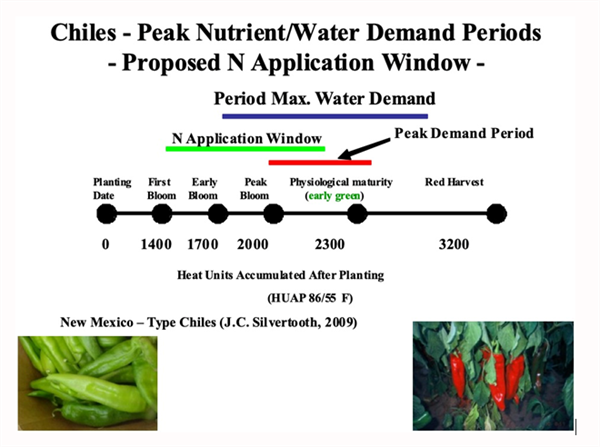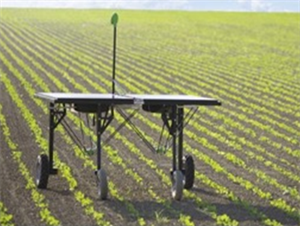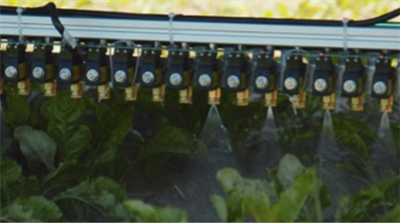
Crops need to be monitored during all stages of growth to best manage water and nutrient inputs. Taking crop condition into account and adjusting nutrient and water management accordingly is critical in achieving the optimum management of a crop and the best use of an irrigation system and fertilization program. This is often referred to as a “feedback” system of crop management (Silvertooth, 2001). This concept and approach to crop management can perhaps be most useful with an irrigated crop production system. Irrigated chile (Capsicum annuum L.) production in the desert Southwest is a good example and it demonstrates the benefits in crop management when coupled with a fundamental understanding of crop phenology (growth and development).
Increased efficiency is an important objective for developing sustainable chile crop production systems. Efficiency can be defined in economic (return on the investment), agronomic (crop system response), or environmental (impact on environmental quality) terms. Each of these concepts of efficiency can be successfully addressed simultaneously, which requires good management and attention to the changes that take place over the growth cycle of a crop.
When monitoring any crop in a production system there are several factors that are very important to consider including: 1) stage of growth, 2) crop vigor, and 3) yield potential. A feedback system of management can be useful in adjusting critical crop inputs such as water and fertilizer inputs (particularly N) in response to actual crop conditions. For example, in the case of irrigated chile, if the crop is experiencing poor vigor and symptoms of stress, it would be very important to identify the source of the stress and make an effort to address or correct it. This could relate to several issues such as pest infestations (insects, weeds, or diseases), water stress, salinity stress, nutrient deficiency, etc. If for example a crop is experiencing poor vigor due to water stress, the application of additional N will not be effectively utilized by the crop until the water stress situation is adequately addressed. Alternatively, if a chile crop is experiencing very high vigor and excessive vegetative growth (often accompanied by a poor fruit load), a more conservative approach with N inputs would be warranted and at the same time it would be important not to impose a water stress per se.
Thus, monitoring a chile crop production system and having a gauge on basic factors such as stage of growth and the plant relationships to water and nutrient requirements are essential in realizing optimum efficiency regarding irrigation and fertilization inputs. Flexibility in management is required to better respond to the crop and production conditions that can change quite rapidly during a production season and will vary from season to season. Accordingly, managers need to be flexible in managing the system in response to the appropriate queues to realize the full potential from a crop production system. This type of agronomic system efficiency is important for both short- and long-term sustainability.
To optimize N management for a chile crop it is important to make fertilizer N applications in the “Nitrogen Application Window” (NAW) described in Figure 1 which provides a baseline for chile growth and development as a function of heat units accumulated after planting (HUAP, 86/55 F thresholds; Brown, 1989; Baskerville and Emin, 1969). Chile crop phenology as a function of HUAP is described in Extension Bulletin AZ1529 (Silvertooth et al., 2010). The NAW is positioned just prior to the period peak N demand by the chile crop during the phase of growth when N demand is rapidly increasing after the crowning stage of development. Nitrogen applications made in this manner in advance of the N demand period increases the probability of fertilizer N uptake and recovery by the plant. Thus, the NAW extends from the crowning stage to just past peak bloom (~1200 – 2300 HUAP).
Chile crop water demand also increases quite rapidly during this same period of growth with maximum chile crop water demand occurring from early bloom until the completion of development of the primary pod set (~1600 – 2500 HUAP). For green chile this peak water demand will extend up to the time of crop harvest. For red chile, peak water demand declines as the crop transitions from ~ 50% green and 50% red chile on the plants, or the stage that is commonly referred to as the maximum “chocolate chile” stage.
For both water and N management it is important to monitor crop growth and development as well crop condition including vigor, fruit load, etc. Water stress should be avoided during these stages of growth and N management needs to be flexible in response to changes in crop condition during these peak periods of demand. Crop monitoring and flexibility are key elements to management for optimum crop production efficiency.
Nitrogen application rates will vary depending on other factors such as residual soil N levels, N concentrations in the irrigation water, previous N fertilizer applications, cropping history for the field and residual crop residues, as well as the current condition of the crop or field in question. Nutrient uptake studies have shown that approximately 180 lbs. N/acre is the maximum amount of total N required by green and red chile crops for optimum yields. Actual total fertilizer N amounts needed by an irrigated chile crop usually equate to a total of 100 – 150 lbs. N/acre for the entire season. However, as previously stated, this rate can vary tremendously depending on actual crop and soil conditions.
Nitrogen management for irrigated chile should be directed to provide the total fertilizer N for a crop within the NAW with split applications toward a maximum target of approximately 100 – 150 lbs. N/acre. Late season N fertilizer applications can delay crop maturity and harvest. Crop and soil monitoring in-season is critical to allow appropriate adjustments in N fertilizer applications to best match in-season conditions in the field optimize this important facet of chile crop management.

Figure 1. Nitrogen (N) application window and maximum water demand period
for New Mexico type chiles in the desert Southwest of the U.S.
References
Baskerville, G.L. and P. Emin. 1969. Rapid estimation of heat accumulation from maximum and minimum temperatures. Ecology 50:514-517.
Brown, P. W. 1989. Heat units. Bull. 8915, Univ. of Arizona Cooperative Extension, College of Ag., Tucson, AZ.
Silvertooth, J.C. 2001. Feedback requirements for nitrogen in irrigated cotton. AZ1201, University of Arizona Cooperative Extension Bulletin.
Silvertooth, J.C., P.W. Brown, and S. Walker. 2010. Crop Growth and Development for Irrigated Chile (Capsicum annuum). AZ 1529, University of Arizona Cooperative Extension, College of Agriculture and Life Science, Tucson, AZ.
Frost and freeze damage affect countless fruit and vegetable growers leading to yield losses and occasionally the loss of the entire crop. Frost damage occurs when the temperature briefly dips below freezing (32°F).With a frost, the water within plant tissue may or may not actually freeze, depending on other conditions. A frost becomes a freeze event when ice forms within and between the cell walls of plant tissue. When this occurs, water expands and can burst cell walls. Symptoms of frost damage on vegetables include brown or blackening of plant tissues, dropping of leaves and flowers, translucent limp leaves, and cracking of the fruit. Symptoms are usually vegetable specific and vary depending on the hardiness of the crop and lowest temperature reached. A lot of times frost injury is followed by secondary infection by bacteria or opportunist fungi confusing with plant disease.
Most susceptible to frost and freezing injury: Asparagus, snap beans, Cucumbers, eggplant, lemons, lettuce, limes, okra, peppers, sweet potato
Moderately susceptible to frost and freezing injury: Broccoli, Carrots, Cauliflower, Celery, Grapefruit, Grapes, Oranges, Parsley, Radish, Spinach, Squash
Least susceptible to frost and freezing injury: Brussels sprouts, Cabbage, Dates, Kale, Kohlrabi, Parsnips, Turnips, Beets
More information:
There are many innovative automated weeding technologies coming out of Europe. One of these is ARA, the high precision, smart spot sprayer being developed by Ecorobotix[1] (Yverdon-les-Bains, Switzerland). Early prototypes were solar powered, autonomous robots that used a spider-like, three-axis delta robot to precisely deliver herbicides to target weeds (Fig. 1). The company has since moved on to a much simpler solution – a fixed boom, tractor pulled implement (Fig. 2). The 19.7’ wide smart sprayer is equipped with 156 individually controlled spray nozzles spaced 1.6” resulting in a spot spray resolution of 5.6 inch2 (2.4 x 2.4 inch). The claimed travel speed is 4.5 mph equating to a work rate of 10 ac/hr. The machine uses computer imaging and artificial intelligence for crop/weed differentiation to identify and target weeds. AI weeding models have been developed for a variety of crops including several vegetable crops – onion, lettuce and spinach. In addition to weed control, the smart sprayer can be used to spot apply beneficial products to only the crop plant. A company video showing the device operating in onion crops can be found by clicking here or on the image below.
As I have mentioned before, robotic and automated weeding technologies are advancing at a very rapid pace. If you know of a new technology that would be of interest and appropriate for this newsletter, please feel free to contact me.

Fig. 1. Solar powered autonomous weeding robot developed by Ecorobotix,
Switzerland. The unit is equipped with three-axis delta robot arms to precisely
deliver herbicides to target weeds (Photo credit – Ecorobotix).
Fig 2. Precision weeding machine developed by Ecorobotix, Switzerland. The unit
is equipped with individually controllable spray nozzles mounted on a 19.7’ wide
spray boom to spot spray weeds (Photo credit – Ecorobotix).

Fig. 3. Precision spray boom comprising 156 spray nozzles for spot spraying
weeds. Spot spray resolution is 2.4 x 2.4 inches. (Photo credit – Ecorobotix,
Switzerland).
[1] Reference to a product or company is for specific information only and does not endorse or recommend that product or company to the exclusion of others that may be suitable.
Growers and PCAs asked about the potential injury that can be caused by a mix of RoNeet (Cycloate) with Dual Magnum (S-Metholachlor) to spinach. We did a small evaluation including the treatments suggested by our friends to collect data. A 1.33pt rate for Dual M and 4.0 pt of RoNeet was sprayed for this trial. The lower Dual M recommended rate by the SLN for AZ in 2017 of 0.33 - 0.67 pt per acre was not included in the trial1. Here’s the treatment list:
Plots consisted of two rows 30ft long replicated four times with 10 seed lines, and the test was established in a randomized complete block design with four replications. All treatments were applied preemergence. A CO2 backpack with a 4 flat fan nozzle boom spaced at 20” was used delivering 20 gallons/acre.
Planting was done on Nov 17, 2022, then the next day the treatments were applied and incorporated immediately with sprinkler irrigation. Crop injury was evaluated on December 13, 21 and 27. The combination of RoNeet plus S-Metolachlor at the rates above mentioned presented the highest phytotoxicity symptoms in the form of chlorosis, stunting, and reduced stand. Also, Dual Magnum alone at the rate of 1.33 pt/a presented injury in lower proportion compared to the combination with RoNeet. In this evaluation the 4pt/a rate of RoNeet did not present injury to the spinach as you can see comparing with the untreated plots below. Weed control data was not collected due to inconsistent and low populations. Only phytotoxicity was evaluated.
The most representative images of the plots are below:

Figure 1. Preemergence herbicide injury evaluation on spinach
Results of pheromone and sticky trap catches can be viewed here.
Corn earworm: CEW moth counts remain at low levels in all areas, well below average for this time of year.
Beet armyworm: Trap increased areawide; above average compared to previous years.
Cabbage looper: Cabbage looper counts decreased in all areas; below average for this time of season.
Diamondback moth: DBM moth counts decreased in most areas. About average for this time of the year.
Whitefly: Adult movement beginning at low levels, average for early spring.
Thrips: Thrips adult counts reached their peak for the season. Above average compared with previous years.
Aphids: Aphid movement decreased in all areas; below average for late-March.
Leafminers: Adults remain low in most locations, below average for March.